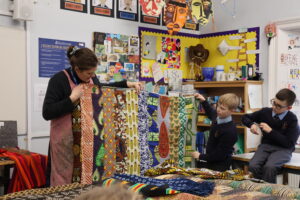Beachborough Newsletter: Friday 24th January 2025
Head’s Blog
“Environment is the invisible hand that shapes human behaviour.” James Clear
The environment in which children learn is just as important as the lessons they are taught. A well-thought-out, engaging learning environment is not just a backdrop; it is an active contributor to the learning process. The spaces we create, both physical and emotional, inspire curiosity, spark imagination, and empower children to take ownership of their learning journey.
This term in the Boardman, one of our areas of focus has been the children’s learning environment. From the enabling environments in the Early Years Foundation Stage (EYFS) to the carefully curated working walls in PP1 to Form IV, we want our classrooms to support exploration, collaboration, and meaningful learning. Classrooms come alive with possibility, they inspire children to ask questions, take risks, and to grow in confidence.
As James Clear reminds us, the environment shapes behaviour, and nowhere is this more evident than in EYFS, where the environment is sometimes referred to as the “third teacher.” Every aspect of this special space is designed to encourage exploration, discovery, and imaginative play. From a water tray sparking scientific experimentation to a construction area honing early engineering skills, or a book corner inviting storytelling, these spaces go far beyond play; they offer rich opportunities for meaningful learning.
As the children transition from EYFS into PP1 and beyond, the approach evolves, yet the core principle remains unchanged: the environment continues to play a pivotal role in fostering active engagement and independence. One of the most effective tools in these classrooms is the use of working walls.
Working walls are not just decorative. They are dynamic, interactive displays that evolve alongside the children’s learning. These walls act as a visible record of the learning journey, offering prompts, strategies, and key vocabulary to support children as they tackle new challenges.
Working walls support learning in many ways: fostering independence by encouraging children to refer to them when stuck and celebrating progress as examples of their work are added. The wall becomes a testament to collective effort and achievement.
At Beachborough, we remain committed to nurturing this playful, curious approach to learning as we continue to develop our classrooms and outdoor spaces. By creating enabling environments and dynamic working walls, we aim to ensure that every child feels inspired to ask questions, explore new ideas, and grow as confident, creative learners ready to embrace the world.
Wishing you all a great weekend and I look forward to seeing many of you at SPLASHTASTIC on Saturday.
Simone




 Shalomi Jebitha Jebaratnam, our graduate music teacher, has shared insights into her academic journey during her Master’s program in Music Education at Kingston University, London. Having completed the program in 2023–2024, and graduated this week, Shalomi described her time at the university as a “blessed and incredible journey” filled with valuable learning experiences and cherished memories.
Shalomi Jebitha Jebaratnam, our graduate music teacher, has shared insights into her academic journey during her Master’s program in Music Education at Kingston University, London. Having completed the program in 2023–2024, and graduated this week, Shalomi described her time at the university as a “blessed and incredible journey” filled with valuable learning experiences and cherished memories.




 Are you or anyone you know interested in attending a stay and play event for children aged 2-4 years?
Are you or anyone you know interested in attending a stay and play event for children aged 2-4 years?
 We can’t wait for Ultimate Activity Camps to return this year, with camps running during the Easter and summer holidays. These camps offer an incredible opportunity for children to discover new activities, boost their confidence, and make lasting friendships. Each week is packed with over 40 thrilling sports, games, and creative activities, all delivered in a safe and fun environment inspected by Ofsted.
We can’t wait for Ultimate Activity Camps to return this year, with camps running during the Easter and summer holidays. These camps offer an incredible opportunity for children to discover new activities, boost their confidence, and make lasting friendships. Each week is packed with over 40 thrilling sports, games, and creative activities, all delivered in a safe and fun environment inspected by Ofsted. The Oxford Brookes Science Bazaar is taking place on Sunday 1st March 2025, and it’s a free event to attend as a family. Hands-on activities, workshops, demonstrations, talks, and the opportunity to meet specialists will all be available.
The Oxford Brookes Science Bazaar is taking place on Sunday 1st March 2025, and it’s a free event to attend as a family. Hands-on activities, workshops, demonstrations, talks, and the opportunity to meet specialists will all be available.
 On Monday 20th January, our U11 and U13 boys and girls’ cross country teams competed in the annual Spratton Hall relays. The relays format of the afternoon meant that the four runners selected each ran a leg of 1600 metres, which included a steep hill towards the end of the lap, before passing on to the next competitor in turn.
On Monday 20th January, our U11 and U13 boys and girls’ cross country teams competed in the annual Spratton Hall relays. The relays format of the afternoon meant that the four runners selected each ran a leg of 1600 metres, which included a steep hill towards the end of the lap, before passing on to the next competitor in turn. On Monday, we took a squad of 8 girls to Stowe to participate in the U13 prep school tournament. Some great netball was played, and we came 3rd overall. Bella and Grace’s shooting was on form, and our centre court players were brilliant at feeding the circle. Defensively, we put up a real fight and made the opposition work for their goals. It was a really great tournament for us and great to see the training which we had done in the morning Games session in full flow on the court. Well done!
On Monday, we took a squad of 8 girls to Stowe to participate in the U13 prep school tournament. Some great netball was played, and we came 3rd overall. Bella and Grace’s shooting was on form, and our centre court players were brilliant at feeding the circle. Defensively, we put up a real fight and made the opposition work for their goals. It was a really great tournament for us and great to see the training which we had done in the morning Games session in full flow on the court. Well done! On Monday 20th January, thirteen of our Beachburians performed in a drum concert, alongside their teacher, Mr McNulty. All of our musicians did exceptionally well, and it’s wonderful to see their skills and confidence growing with each performance.
On Monday 20th January, thirteen of our Beachburians performed in a drum concert, alongside their teacher, Mr McNulty. All of our musicians did exceptionally well, and it’s wonderful to see their skills and confidence growing with each performance. As part of Children’s Mental Health Week, Brackley Library is holding an event on Monday 3rd February 9.30am to 12.00pm at which the following organisations will have stalls:
As part of Children’s Mental Health Week, Brackley Library is holding an event on Monday 3rd February 9.30am to 12.00pm at which the following organisations will have stalls: On Sunday 27th April, Mr Blee will be running the Shakespeare Half Marathon, all in aid of raising money for Mary’s Meals!
On Sunday 27th April, Mr Blee will be running the Shakespeare Half Marathon, all in aid of raising money for Mary’s Meals!











